Ferrari nose hole
In year 2008, after so much speculation, Ferrari have once again introduced a completely new concept in Formula One, now by cutting open the nose cone and creating a duct through the nose itself. Although the idea is not new, it is the first real implementation in this area of aerodynamic use.
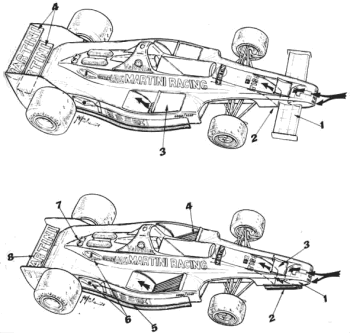
As I said, idea with this kind of nose cone is not a new. There is almost 30 years when was used first time. Great Collin Chapman used it first time on Lotus 80 to maximize ground effect. He used design like on pictures, but he used skirts to channel air below nose cone to isolate this area and to create low pressure below nose cone. After first try with front wings and without skirts, he removed wings and used only skirts. Reutemann who drive this car was totally disappointed because car was undrivable over uneven surface because skirts were not movable, and front side lose very easy downforce when skirts do not touch the ground.
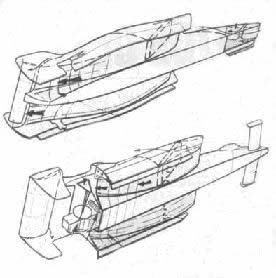 |
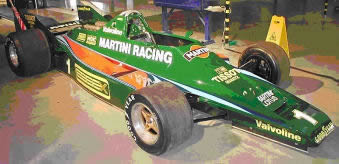 |
Ground effect - wing car Lotus 80 |
|
This time, Ferrari used same idea but in different concept.
The fact is that the nose cone obstructs the front wing's upward air stream.

In the way Ferrari implemented this idea, problem with turbulent air and high pressure area below nose cone was resolved.
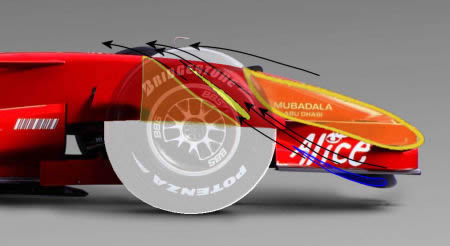
In the centre of the wing ("spoon area") below nose cone, the airflow previously hit the underside of the cone, creating extra drag, high pressure area and with that also reducing the efficiency of the front wing itself. This 'hole in the nose' is aimed at making use of the high-pressure air that builds up between the front wing and the underside of the nose and expel it on upper side of the nose cone.
This would improve the car's downforce by sending more air and better airflow to the rear wing.
What Ferrari has done is to create a channel inside the nose cone that takes this high-pressure region and vents it over the top of the chassis.
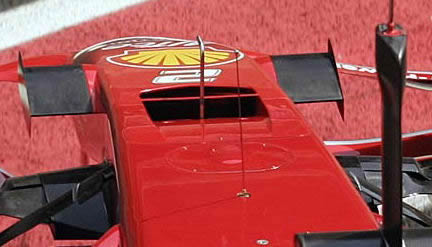
From overhead shots the hole's outlet can be seen, with one large exit split into two. This helps the exit air flow merge better with the flow already passing over the car. It exits above the nose, just ahead of the front suspension components.
Despite its negative drag effect on top of the nose, the improvements under the nose are substantial. Not only will the upward airflow be smoother, it will also create a lower pressure area under the nose. As a result, molecules of air tend to fill that void and flow faster along the front wing, further improving the efficiency of the front wing.
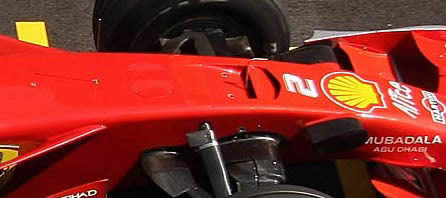
This concept has a few negatives in a setup point of view. Nose hole must be at exact position in relation with front wing and angle of front flaps. In other words, air exiting front wing must find direct way trough the hole. If an angle of front wing is smaller, the air will overshoot the hole, and if angle is higher (bigger) the air will undershoot the hole. In booth situations resulting gain of this concept is not positive. Drag over the nose is higher, and pressure under the nose is almost the same as without hole. That is a reason why Ferrari decided to use this design only on certain circuits, mainly the slow circuit where even a small gain on downforce is important.
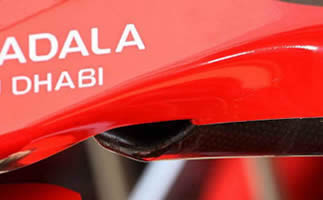 |
 |
Air intake hole under the nose |
|
Interview with John Iley, Ferrari aerodynamicist
Q: How was the hole in the nose born ?
Iley: ''It's the result of continuous work on the car, something that never stops, not even in a period in which the regulations remain unchanged for a long period. We have lots of memories, preceding experiences and ideas that have been put aside. It occurs that we find something interesting but that we cannot use instantaneously because it wouldn't be working on the car we have at that very moment. But something that isn't useful today could become useful tomorrow.''
Q: How many of the solutions you experiment with are effectively used in the end ? One out of nine ?
Iley: ''Maybe, but it's important to underline that there's always a good reason why an idea is discarded, or momentarily discarded. The difficulty of passing the crash test for example. It's up to technicians like me to decide when certain solutions are to be introduced. Saying:' right, this is the moment for it'.''
Q: But then do you never invent something new ?
Iley: ''We usually apply concepts that have been known for years. When you go and 'explore' the history of Formula 1 then you'll find many ideas that could be made to work today. But it depends on how your car works. Not every solution works on every car.''
Q: How much times goes past between coming up with an idea and introducing it on track ?
Iley: ''That's not the right way the question should be put. Let's take the nose with the hole in it: we've been thinking about it for a while, we wanted to introduce it earlier but we weren't able to simply put it on the car. Together with the hole, which is the main thing people talk about, a whole range of other, less evident solutions were necessary to be introduced as well. On top of that we've encountered some problems with the production. It is obviously essential to have a very efficient organization to try out everything, not wasting your time. When you test a component too early, then the entire car is different compared to what you have in mind (as to when the component is to be introduced) and the interaction between the various parts doesn't work.''
Q: Is there room for the fantasy of the designers in the age of the computer ?
Iley: ''Of course. The computers are programmed. We decide which and how much data we insert. The contribution from the drivers is fundamental also. The programs that are used for the simulation of the aerodynamics and other technologies are useful to understand if the things we've thought up will give good results. Or bad results, which is just as interesting: it could be a little alarm bell that tells you not to 'peeve' the car too much because it's very sensible to modifications.''
Q: Will other teams copy your famous nose within two or three races ?
Iley: ''It's not easy. I don't think it will happen. Each car has its own geometry. The hole works well with ours. When you notice a team has copied a solution of yours, then you can conclude that the car of the team has a similar geometry which could give you useful indications.''
Q: How many people work in Ferrari's aerodynamical department ?
Iley: ''I'm afraid I cannot say that. That's sensible information. We're a big group, but elsewhere, in other departments there are groups that are bigger still.''
Q: If your ideas come from the past, then where have you gone 'fishing' for the hole in the nose solution ?
Iley: ''I've been in Formula 1 for eleven years. The idea was going around. It was only necessary to find the right moment to exploit the idea. And this was the right moment, with the new regulations that are to come. It's important to begin with exploiting areas that are not considered by many, such as the geometry of the design. Because everything could give you an advantage. When I started working in Formula 1 it wasn't necessary to be at the limit of each aspect of the car. Now it is necessary, and will be even more so in the future.''
Q: Are you not afraid by the reduced role of the aerodynamics in 2009 ?
Iley: ''The implications of the new regulations are not completely clear yet. And then it's somehow comforting to know that in my working field there's still some freedom to work, whereas other areas, that of the engine for example, are almost completely frozen for development. Maybe we can do less compared to the past, but the little bit we can still do is more important. I'm fascinated by the challenge.''
Q: Will the new regulations really enable more overtaking ?
Iley: ''The 'mechanism' with which the regulations for 2009 have been designed is the right one: a group of independent technicians which have been studying the problems for a long time. The geometry of the car will play a key role, something I'm very pleased about. I think this is a good base to begin with. The spectacle and the public will rejuvenate because of it. At least at the start. My worry is that you never know how the regulations will be interpreted by technicians on the long term and which side effects, such as the electronics, will interact with the regulations in place.''
Q: Apart from being an engineer you really seem to be passionate about it all...
Iley: ''I am. The world of motors makes you addicted, more or less. And when you're as passionate as I am you become a driver or a technician.''
During Turkish GP 2008, Ferrari did not use his vented nose. The vented nose was again present for at Monaco GP same year. Reasons for that are explained before. Generally, the nose will be used by Ferrari at tracks where more forward downforce is needed, this design is not favorable for circuits where the front wing is set at low angles of attack.
The team make small improvement of design by adding a two triangular, inclined winglets at each side of the nose cone to increase the effect of the air channeling. The aerofoils help to push air upwards, similar to what happens inside the nose cone and to divert away turbulence generated by the front-wing pillars and enhance the efficiency of the bottom hole.
As a result, downforce will be even better, despite the drag penalty.

From year 2009, rule changes are banned all aero appendages on car body, like chimneys, flipups, Ferrari nose hole stile adds and turning vanes.






